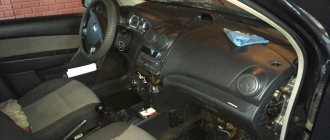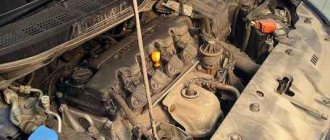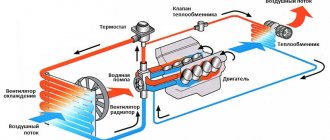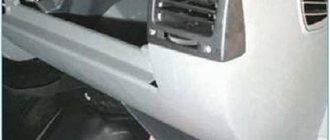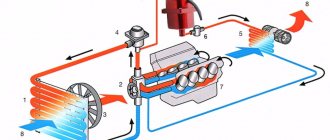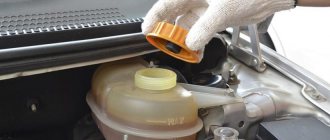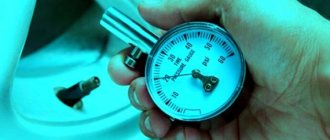The heater acts as a kind of stove, supplying warm air into the car interior. And if in the warm season it is practically not used, then in the winter you cannot do without it. The operation of the stove ensures not only the comfort of the driver and passengers, but also the blowing of the windshield, which is so important in frosty weather. Its failure can be a rather unpleasant surprise, especially in winter.
If you notice that your car's heater does not provide sufficient heating to the supplied air, the heater core may be clogged.
How to wash its channels and how to do it at home, we will talk in this article. We will also look at the most popular folk cleaning products used for these purposes by our car enthusiasts.
How to determine radiator obstruction
Before flushing the heater radiator, you should make sure that it is the cause of insufficient heating of the air supplied to the cabin, and also that other elements of the cooling system, such as the thermostat and the liquid pump (pump), are operating normally. First, warm up the car engine to operating temperature. Lift the hood and locate the pipe leading from the thermostat to the radiator. If it is hot, then the thermostat is working properly. You can determine the pump's performance by opening the expansion tank and starting the engine. If coolant flows into it from the hose coming from the cooling radiator, then the pump is working.
After making sure that the cooling system is working, with the engine running, open the heater valve so that coolant can flow through it. After this, lift the hood and find the inlet and outlet pipes of the heater radiator. They should both be hot. This indicates that coolant circulates freely in the system. If the outlet pipe is a little warm or cold, the radiator is clogged.
Acidic products
It is better to wash copper heater radiators with a 15% sulfuric acid solution - strong alkalis (caustic soda contained in Krot) can damage them. To prepare the solution you need battery electrolyte and distilled water. The concentration can be checked with a hydrometer. A 15% solution corresponds to a density of 1.1 grams per cubic centimeter (electrolyte density 1.28).
Flushing the stove radiator with electrolyte requires control - sulfuric acid is very aggressive.
To flush the stove radiator with citric acid, the proportion is approximately the following: 100 grams of powder in a volume of water the size of a bucket (7 - 10 liters). You can also wash the stove radiator with 9% table vinegar.
Wash the stove with Coca-Cola only in extreme cases and remove any remaining dirt with water as thoroughly as possible. The sugar contained in this drink can turn into caramel, which will damage other elements of the engine cooling system. It’s better not to experiment, despite stories of successful results.
Why does the radiator clog?
The cause of a clogged heater may be:
- long period of operation, as a result of which the radiator channels become clogged with oxidation products and dirt;
- the use of low-quality coolants, which may contain substances that accelerate the oxidation of metals;
- use of water with a high salt content as a coolant;
- ingress of chemically active liquids (fuel, oil) or dirt into the cooling system.
Pros and cons of each method, possible risks
Flushing the radiator with citric acid:
We recommend: Self-replacement of the coolant temperature sensor: 2 types and 7 signs of their malfunction
Advantages: low cost, high efficiency.
Disadvantages - if you overdo it with acid, it can lead to quite unpleasant consequences - over time, the acid can corrode the rubber and plastic elements of the system. Citric acid is highly aggressive, so you perform such flushing of the heater radiator at your own risk.
Flushing the radiator with Coca-Cola:
Advantages - low cost, speed, high efficiency (Coca-Cola contains so-called orthophosphoric acid, which effectively fights scale).
The disadvantages of such washing are associated with the gas and sugar content in Coca-Cola. Sugar, which is found in Coca-Cola, can clog the radiator, and the increased state of gases can have a negative effect on the entire system.
Flushing the heater radiator with special means:
Advantages: efficiency, no risks.
Disadvantages - slow action.
Washing methods
There are two ways to clean the heater: by removing it from the car and without removing it. Each method has its own advantages and disadvantages. In the first case, the radiator is dismantled along with the tap. This makes it possible to assess the condition of these components of the cooling system, as well as get rid of dust and dirt on the heater lamellas. However, this method is not suitable for everyone, since before flushing the stove radiator, it will take a long and tedious time to remove it, and then install it. In some cars, to get to the heater, you even need to disassemble the dashboard. If you don’t particularly want to do this, you can clean it without dismantling it. If cleaning is performed correctly, its effectiveness will be the same in both cases.
Popular radiator cleaning products
If you have decided on the method, all that remains is to choose how to flush the stove radiator at home. Let's start with the fact that you can buy special liquids for cleaning the cooling system in car dealerships. They cope with their task quite effectively, but rather than flush the stove radiator with strange chemicals, and even at a considerable cost, it is better to use proven folk remedies, which you can even find in your kitchen. These include:
- milk serum;
- citric acid solution;
- special powders and liquids for cleaning sewer pipes (“Mole”, “Silit”, “Komet”, etc.);
- popular drinks such as Coca-Cola or Fanta;
- solution of caustic soda (caustic soda).
Briefly about the theory of flushing the stove radiator
Any more or less modern engine is made of cast iron (cylinder block) and aluminum alloy (everything else). On the latest models produced from 2005-2009, aluminum cylinder blocks are increasingly being used.
At a mileage of about 80-120 thousand, the stove radiator can be a depressing sight. If you don't flush the cooling system.
The heater radiator, as well as the main radiator of the cooling system, is made of both aluminum alloy and copper. We reviewed the best models not long ago . However, if you neglect the cooling system, and the condition of the engine in general, the system becomes clogged, scale and dirt deposits form on the walls of the channels, on the pipes, and inside the honeycombs of the radiators.
It is important to clearly understand what exactly we must clean inside the cooling system and the heater radiator in particular:
- Fats . These are any inclusions of oils, lubricants, sealants, and fuel in the antifreeze composition. All this settles on the walls of the system and negatively affects its efficiency. Not to mention the inability of the radiator to perform its functions - to release heat into the atmosphere or into the cabin, if we talk about the heater radiator.
- Salts . This is the same scale that forms on the walls of the cooling system during engine heating . Almost the same story happens in an ordinary kitchen kettle. The cleaner the water, the less salts it contains and the less scale. In the cooling system, the principle of limescale formation does not change - the worse the antifreeze and the higher its wear, the more scale there will be.
It is equally important to understand that all fats can be removed with an alkaline solution, and any scale can be removed with an acidic solution.
We cannot claim that all branded flushes for the cooling system, without exception, are profanation and marketing of pure water. Nevertheless, a huge part of those liquids that are on sale and cost no less than good antifreeze can not only be useless, but also harm the engine.
Interesting on the topic: Servicing Suzuki Grand Vitara: automatic transmission oil change, how to choose the best
Here's the thing. Since we have conditionally divided all the deposits in the cooling system into fats and salts, we must fight each of them with our own means. There simply cannot be a universal option that would equally effectively clean the engine from salts and fats.
We smoothly approached the most important thing - how to clean the stove radiator and the entire cooling system as efficiently as possible. No negative consequences.
Choosing the right cleaning product
Considering that heaters are made of copper and aluminum, you need to know exactly what you can use to clean the heater radiator from these products, and what you can’t. The fact is that aluminum reacts very quickly with alkali and instantly oxidizes, so it is better not to use alkaline products to clean products made from it.
But then, how to rinse an aluminum stove radiator so as not to cause harm? Only acid solutions or whey. The latter, by the way, is the least aggressive, although it requires more time to dissolve the scale. But in our case, it’s better to spend a little more time and be sure that the heater will still serve us, than to quickly flush the radiator of the car’s heater, using products that can lead to its failure. For copper, on the contrary, products containing alkali are more suitable.
Radiator flushing with removal
Having decided what can be used to flush the radiator of a car’s heater, we begin the process itself. Regardless of the method chosen, the first step is to drain all the coolant from the system. After this, we dismantle the radiator along with the tap. We check the operation of the tap and clean the outside of the heater, removing dirt and dust from its lamellas. Before flushing, it is better to disconnect the tap.
Next, we rinse the radiator with a stream of water, directing it into one of the pipes. When the dirt stops coming out, tightly close any heater pipe, and fill the second with a pre-prepared solution. And it's better if it's hot. Leave the radiator to cool for about an hour.
After the specified time has passed, drain the cleaning agent from the heater and rinse it again with running water. For greater effect, you can use a hose by putting one end on the radiator pipe and connecting the other to the water supply. We rinse until dirt stops coming out of the heater. How effective the cleaning was can be determined by blowing into the connected hose. If air passes through the radiator channels freely, then our work was not in vain. All that remains is to screw on the faucet and install the heater in place.
Preparation for major flushing
To clean the interior heater radiator directly on the car you will need:
- There are two types of detergent – alkaline and acidic;
- standard set of keys, screwdrivers and pliers, funnel;
- a low-power water pump (a household circulation unit for heating and an electric pump from a Gazelle truck are also suitable);
- two hoses 2 meters long with tightening clamps;
- distilled water in an amount of 3 volumes of the cooling system of your car;
- boiler and bucket;
- old nylon tights or gauze folded in three.
Also prepare a container for draining old antifreeze and the required volume of fresh coolant. Often, car enthusiasts wash the heat exchanger of the stove without completely emptying the pipelines and engine jacket, but then all the debris contained in the old antifreeze will again flow into the clean radiator.
It is more convenient to carry out work in a garage equipped with an inspection ditch. To remove deposits without removing the heater from the car, completely drain the antifreeze from the engine in the following order:
- Allow the engine to cool to room temperature and place a container underneath for antifreeze.
- Unscrew the plug on the cylinder block with a wrench, then open the cap of the expansion tank.
- When all the antifreeze has flowed out, screw the plug back into place. If the main radiator has a second drain, repeat the operation.
- Disconnect the pipe at the highest point of the system - on the throttle valve or carburetor heating unit.
On some cars, emptying is prevented by covers that protect the engine compartment from dust from entering from below. There are 2 options to solve the problem: remove the protection or use a long hose attached to the neck after unscrewing the plug.
We recommend: Do-it-yourself connection of fog lights via a relay
How to flush a stove radiator without dismantling it
The principle of flushing the radiator without dismantling it is similar. After draining the coolant, disconnect the hoses from the heater pipes. Here we additionally need two hoses of suitable length and diameter. They need to be connected to the radiator pipes. The heater valve must be in the open position.
Of course, it is better to rinse with running water. To do this, you can use a water supply, or some kind of device like a liquid pump. But if you don’t have anything like that at your disposal, we carry out the washing as follows. We lower one of the hoses connected to the radiator down and place some container under its end. We insert a regular watering can into the second hose and begin to pour clean water into it. Spill until the water runs clear.
After this, close the outlet pipe (hose) and pour the prepared cleaning solution into the radiator. After waiting an hour, drain the liquid and rinse again with water until it comes out clean.
Upon completion of the procedure, connect the system hoses to the heater and fill in coolant.
Global purge
There is another method that will help clean the entire cooling system, including the radiator. To do this, you need to drain the coolant and fill in a cleaning agent instead. Here, of course, neither soda nor citric acid will work. It’s better to use professional products or, as a last resort, whey.
When the system is filled with cleaning agent, you need to start the engine and let it run. The only thing is to monitor the engine temperature to prevent it from overheating. When the engine has been running for 10-20 minutes, the liquid can be drained, after which the system must be rinsed with clean water several times using the same principle.
In some cases, it is better to use this cleaning method than to wash the stove radiator separately. It will remove dirt and scale from the entire cooling system.
Flushing the heater radiator without removing it from the car. Technology
We will use regular baking soda as an alkali. It copes well with fatty deposits such as oil film. Cleaning with soda will be carried out first, since it is important for us to remove any hint of oily deposits. Otherwise, they will not allow you to remove the scale.
Interesting on the topic: Flushing the engine when changing the oil. To wash or not to wash?
Scale after unsuccessful radiator flushing.
The most effective and harmless acid for the engine is citric acid, which is sold in any store. Citric acid will remove all scale, which can be verified when draining the engine. In this case, the acid activates the surface of the metal and makes it susceptible, including to oxygen.
That is why flushing the system with water after acid is a serious mistake, leading to the formation of corrosion on the surface of metals.
Corrosion cannot be avoided even if we flush the stove radiator and the entire system with distilled water. Yes, it contains a minimal amount of minerals and salts, but oxygen is present there in any case, and oxidation of an unprotected activated metal is a direct road to corrosion.
To completely clean the cooling system of scale and oil deposits, we will need:
- A pack of baking soda.
- Citric acid 200-300 g.
- Bottled, not necessarily distilled, water.
- New high-quality antifreeze.
- Time, about 5-6 hours.
The question often arises - why can’t you just flush the heater radiator by disconnecting it from the cooling system, is this both simpler and faster? Indeed, it is faster and perhaps simpler. However, this option can only be considered as a temporary measure, since all the dirt and scale from the engine will sooner or later return to the heater.
Now that we have everything figured out, let’s start washing, strictly following the procedure and technology.
Important! Warming up the car and idling it should only be done outdoors to avoid poisoning from exhaust gases.
Draining old antifreeze
Probably everyone knows how to drain antifreeze in any car. The only difficulty is that we need to try to drain as much liquid as possible. If there is a separate plug in the cylinder block, drain both from there and from the radiator. There should be absolutely nothing left in the system.
Pour in a solution of water and soda
We tighten all the plugs and taps, dilute 200 g of soda in 10 liters of water. The proportion is calculated based on the volume of the cooling system of a particular engine. It is important to remember that both the engine and the water should be approximately the same temperature (the engine is cool, the water is about 20 degrees). Pour the solution into the system.
Interesting on the topic: Working on errors: P0135, what it is, how to reset, causes and their elimination
Warm up the engine for 30 minutes
We start the engine and drive it at idle speed for about half an hour. In this case, the engine must reach the operating temperature range for the thermostat valve to open. This is important, because if the thermostat does not open, the liquid will circulate only in a small circle - the cylinder block, the head, the stove.
To make the engine warm up faster, you can put an additional load on the generator, turn on the lighting or other consumers, but not the stove, since it will remove heat from the engine. If the engine is diesel, you will have to maintain the speed slightly above idle to warm up the fluid before the thermostat opens.
Engine cools down, flush with water
After warming up for 30 minutes, turn off the engine and leave it alone for an hour to allow the soda to work as efficiently as possible. After a 60-minute break, drain the rinse with any remaining dirt and fill it with clean water.
Water is needed to wash away the remaining soda, since it will neutralize the acid, which we will add later. Let the engine run for a few minutes on the water, then drain it.
Filling with acid solution
When the remaining soda is washed off with water, dilute 200 g of citric acid in 10 liters of water. Just like the first time, let the car idle for about 30 minutes at operating temperature. After this, turn off the engine and let it cool for an hour.
We repeat the heating-cooling cycle (30 minutes of warming up - 1 hour of cooling) 3-5 times, as long as you have enough patience. At this time, the metal surface is finally cleared of scale and can actively interact with oxygen.
Neutralize acid with soda solution
At this stage, it is very important to rinse the engine with a soda solution (50 g per 10 l), but under no circumstances with water. We follow the same scheme, start the engine, warm it up for 30 minutes, then drain the solution and immediately fill in fresh antifreeze. After baking soda, you cannot rinse the system with water for the reason stated above; we immediately pour in antifreeze .
The method we have presented here is considered the safest for the engine and radiators, as well as the most effective for the comprehensive removal of salts and fats from the cooling system. Even the most expensive cleaning products are unlikely to give the best effect.
If you follow these recommendations, the cooling system will always be clean, the heater radiator will always be hot, the engine will warm up quickly in cold weather, and the interior will be warm.
